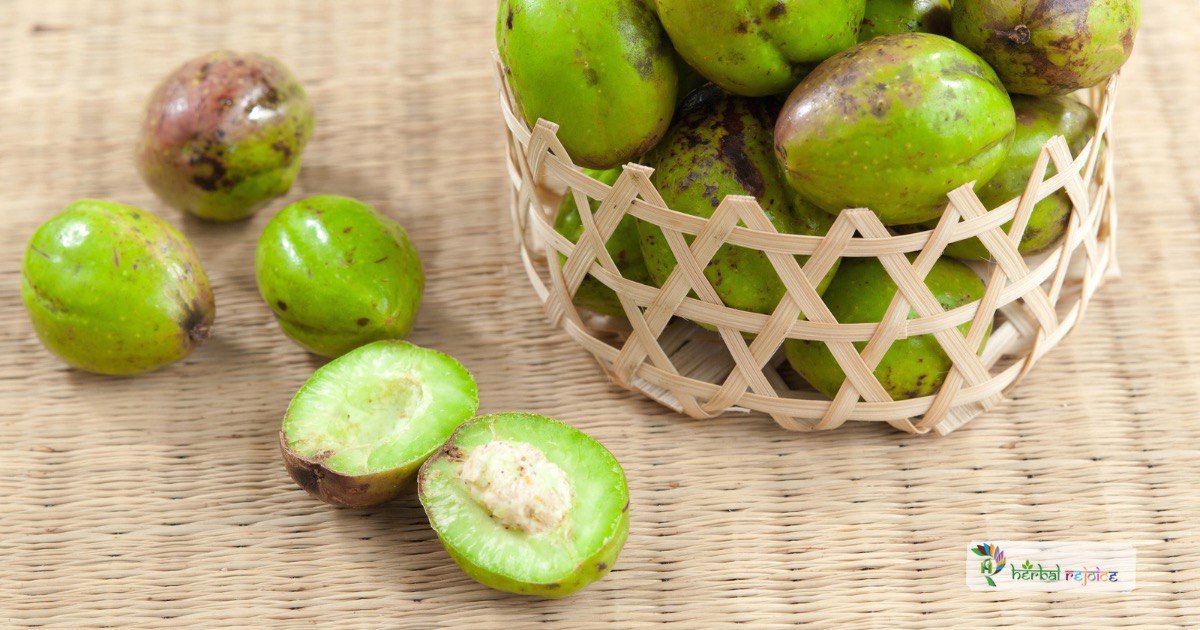Introduction
Terminalia bellirica Roxb., commonly known as Belleric Myrobalan or Bastard Myrobalan, is a medicinal plant that belongs to the Combretaceae family. Myrobalan is used to treat vomiting’s and worm infestations. It consists of laxative and purgative properties which helps to relieve constipation. The fruit of this plant acts as a purgative when half ripe and as an astringent when fully ripe. It is also known for its antipyretic properties.
Names and Habitat
In Ayurvedic medicine, it is known as Bibhitaka, Vibhitaka, Bibhitaki, Bibhita, Baibhita, Aksha, Akshaka, Kaamaghna, Kalidru Kali, Karshaphala.
In Unani medicine, it is referred to as Balelaa or Baheraa, while in Siddha/Tamil medicine, it is called Thaanrikkaai or Thandri.
It is found throughout deciduous forests in India.
Key Components Of Myrobalan
The Ayurvedic Pharmacopoeia of India recommends the use of Belleric Myrobalan in powdered form for treating emesis and worm infestations.
The fruit contains several bioactive compounds, including beta-sitosterol, gallic acid, ellagic acid, ethyl gallate, galloyl glucose, chebulagic acid, and a cardiac glycoside called bellaricanin.
These compounds contribute to its therapeutic properties. The fruit of Belleric Myrobalan contains similar components to Chebulic Myrobalan (Terminalia chebula), except for corilagin and chebulic acid.
The fleshy fruit pulp of Belleric Myrobalan contains approximately 21.4% tannins, which include both condensed and hydrolysable types. Furthermore, studies have shown that the flower of this plant exhibits spermicidal activity.
Potential Benefits Of Myrobalan
The fruit is commonly used in prescriptions for treating conditions such as diarrhoea, dyspepsia, biliousness, cough, bronchitis, upper respiratory tract infections, tropical pulmonary eosinophilia, and allergic eruptions.
Studies have shown that the fruits of Belleric Myrobalan have hepatoprotective effects and can protect against liver injury induced by CCl4 in mice.
Additionally, alcoholic extracts of the fruit have been found to have negative chrono- and inotropic effects on isolated rat and frog atria, as well as a hypotensive effect on rabbit hearts.
These effects were observed in a dose-dependent manner.

Dosage Of Myrobalan
The recommended dosage of Belleric Myrobalan fruit is 3-6 grams in powdered form.
Conclusion
In conclusion, Belleric Myrobalan, scientifically known as Terminalia bellirica Roxb., is a valuable medicinal plant with various therapeutic properties.
Its fruits are commonly used in traditional medicine for treating a range of conditions.
The bioactive compounds present in the fruit contribute to its medicinal benefits, including its hepatoprotective effects and cardiovascular effects.
Frequently Asked Questions(FAQs)
What is the scientific name for Belleric Myrobalan?
The scientific name for Belleric Myrobalan is Terminalia bellirica Roxb.
What family does Belleric Myrobalan belong to?
Belleric Myrobalan belongs to the Combretaceae family.
Where is Belleric Myrobalan found?
Belleric Myrobalan is found throughout deciduous forests in India.
What is Belleric Myrobalan known as in Ayurvedic medicine?
In Ayurvedic medicine, Belleric Myrobalan is known as Bibhitaka, Vibhitaka, Bibhitaki, Bibhita, Baibhita, Aksha, Akshaka, Kaamaghna, Kalidru Kali, Karshaphala.
What is Belleric Myrobalan called in Unani medicine?
In Unani medicine, Belleric Myrobalan is referred to as Balelaa or Baheraa.
What is Belleric Myrobalan called in Siddha/Tamil medicine?
In Siddha/Tamil medicine, Belleric Myrobalan is called Thaanrikkaai or Thandri.
What are the medicinal properties of Belleric Myrobalan?
Belleric Myrobalan has purgative, astringent, and antipyretic properties.
What conditions can Belleric Myrobalan be used to treat?
Belleric Myrobalan can be used to treat conditions such as diarrhoea, dyspepsia, biliousness, cough, bronchitis, upper respiratory tract infections, tropical pulmonary eosinophilia, and allergic eruptions.
What does the Ayurvedic Pharmacopoeia of India recommend the use of Belleric Myrobalan for?
The Ayurvedic Pharmacopoeia of India recommends the use of Belleric Myrobalan in powdered form for treating emesis and worm infestations.
What bioactive compounds are present in Belleric Myrobalan?
Belleric Myrobalan contains bioactive compounds such as beta-sitosterol, gallic acid, ellagic acid, ethyl gallate, galloyl glucose, chebulagic acid, and bellaricani.
What effects does the alcoholic extract of Belleric Myrobalan have on the heart?
Alcoholic extracts of the fruit have negative chrono- and inotropic effects on isolated rat and frog atria, as well as a hypotensive effect on rabbit hearts.
How do the components of Belleric Myrobalan compare to Chebulic Myrobalan?
The fruit of Belleric Myrobalan contains similar components to Chebulic Myrobalan, except for corilagin and chebulic acid.
What percentage of tannins does the fleshy fruit pulp of Belleric Myrobalan contain?
The fleshy fruit pulp of Belleric Myrobalan contains approximately 21.4% tannins, including both condensed and hydrolysable types.
What activity does the flower of Belleric Myrobalan exhibit?
The flower of Belleric Myrobalan exhibits spermicidal activity.
What is the recommended dosage of Belleric Myrobalan fruit?
The recommended dosage of Belleric Myrobalan fruit is 3-6 grams in powdered form.
Is it important to consult with a healthcare professional before using Belleric Myrobalan?
Yes, it is important to consult an Ayurvedic practitioner before using Belleric Myrobalan for medicinal purposes.
What are the therapeutic properties of Belleric Myrobalan?
Belleric Myrobalan has various therapeutic properties, including hepatoprotective effects and cardiovascular effects.


